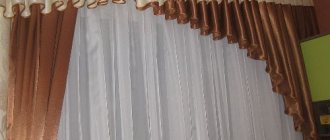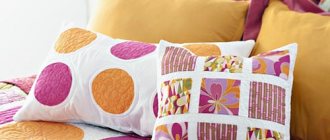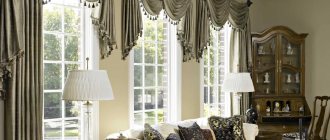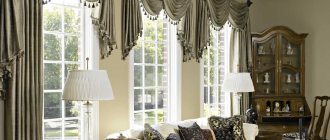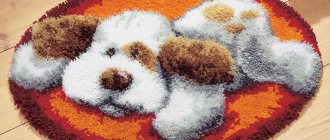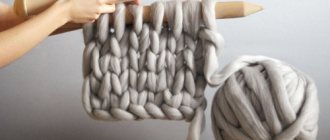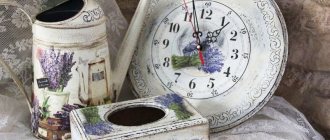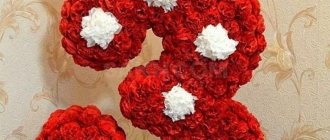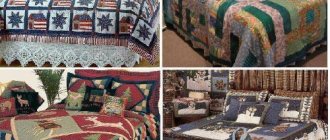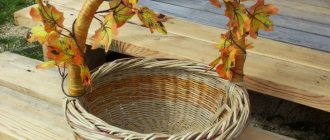Any table will be decorated with a beautiful tablecloth. And even if this is a small home feast or just a family dinner, then a woven covering will create a special atmosphere and festive mood. And if the item is made by a craftswoman from linen and lace, then the wonderful romantic atmosphere will delight everyone with its comfort.
Even if your interior style does not include a fabric design for the dining table, there are times when such a covering is simply necessary.
Required Tools
Before you begin, you need to organize your workplace and select all the necessary materials.
Tools and materials.
We will need:
- scissors;
- ruler;
- pencil or chalk;
- tape measure;
- textile;
- pins;
- needle;
- spool of thread;
- iron;
- sewing machine.
Stitching of facing parts
In overstitched parts with corners, before turning them out onto the front side, allowances in the corners should be cut off in order to obtain a clear, beautiful corner in the finished product. In this case, the following options are possible: a) A straight angle, the stitching goes along both sides of the corner, then the allowance is cut diagonally (Fig. B), when turning out, the remaining allowances fill the corner of the part without excess fabric. b) A straight angle, the stitching goes along one side of the corner, the other side of the corner is formed by a fold of fabric. In this case, the allowance in the corner is not cut off, because when turning the part out, the allowance fills the corner without excess fabric, forming a clear line (Fig. B). c) The angle is sharp, the stitching goes along both sides of the corner, then the allowances are cut to such a size that when turned out they fill the corner without excess fabric (Fig. B).
Selection of material and accessories
First of all, let's decide why we need a tablecloth? Products made from chintz or synthetic materials are wonderful for everyday use in the kitchen. They are easy to wash and iron, and even if a child gets them dirty, they can be easily restored to their original appearance.
A beautiful, elegant tablecloth, sewn by yourself, will decorate the table at which guests will sit during the festive celebration.
Main types of fabrics:
- linen;
- cotton;
- curtain fabric;
- silk;
- lace;
- chintz.
This home decoration piece not only protects the table top, it also becomes an important decorative detail.
If we want to decorate our interior with an exclusive item, then we should choose a model with lace or embroidery.
The tablecloth on the dining table is always the center of attention.
A handmade item made from curtain fabric, the same as the curtains in the room, looks very advantageous.
Previously, tablecloths only decorated the festive table, but today they are an indispensable element of the interior.
Interesting coverings are obtained by sewing a tablecloth from two fabrics. For example, use a colored canvas and make its edging monochromatic.
If you make a tablecloth with your own hands, you will also receive an exclusive product.
A unique festive atmosphere is created by embroidery done in the center of the tablecloth or along the edges of the product.
For everyday use, it is better that the product is made of practical material.
Experienced craftswomen can make coatings by stitching parts of two or three types.
A tablecloth with lush scallops or lace frills will help add solemnity to the room.
If you are interested in holiday options, it is better to give preference to natural fabrics.
Round tables covered with canvas with edges hanging almost to the floor look attractive. If the table is intended for receiving guests, then the overhangs should not be more than 30-40 cm, otherwise people will not be comfortable sitting down and standing up.
For a magnificent special event, a silk product will be one of the best options for table decoration.
A few tablecloths that can be easily changed depending on your mood will help you quickly change the design of the room.
The choice of colors will depend on the decor of your room, as well as personal taste preferences.
If this product is for the kitchen table for daily use, then you should pay attention to practical materials that are easy to clean.
Table decoration using napkins
There are many ways to decorate your table beautifully using napkins. Let's look at some of them.
Accessories
On sale you can find many different accessories for napkins, including clips and rings. These small decorative details can help create an unusual composition:
- Rings allow you to achieve rigor and elegance in your design. They can be decorated with rhinestones, feathers, flowers, personalized letters, made of different materials.
- Ribbons are designed for tying napkins and, if you look at it, they function as rings.
- Clips are also used to secure napkins. Additionally, they can be decorated with flowers or rhinestones.
Folding methods
There are so many options for folding paper or cloth napkins. But from them we can separately highlight several of the simplest and most successful:
- A sail is perhaps the most laconic way to design napkins. For this option, fold the napkin in half, with the fold facing away from you. Then fold the top corners to form a triangle. Next, fold the resulting figure in half (along the seam).
- Roll is most appropriate for official receptions. Fold the napkin in half with the fold facing you. Cover the cutlery with the left and right edges of the triangle. Wrap the resulting envelope.
- French is a very elegant option. Fold the napkin along a diagonal line so that the folded edge remains on the left side. Next, bend the top corner down, leaving about 2 cm of the right corner open. Now fold the right side down.
- The pyramid looks strict, but quite impressive. Fold the napkin diagonally and then fold the left and right sides together, end up. Next, bend the future pyramid along the center line.
- Fan - a product folded like a fan can be placed in front of a large serving plate. A fan in a glass would also be an original solution.
How to measure a table depending on its shape
Whatever your table is, glass, solid or rattan, you can sew an interesting tablecloth for it, which will complement the interior and make the house more comfortable. The shape of the tabletop and its size determine how much fabric we need to buy for cutting. Let's consider all the options and reveal little secrets for beginning needlewomen.
To choose the right shape for a tablecloth, you need to know certain nuances.
Round table
Let's measure the radius, the length of the overhangs and add allowances for the hem of the product.
Both square and round tablecloths look beautiful on round tables.
Example: Tabletop radius – 50 cm, overhang length – 30 cm, allowance – 4 cm. Total 50+30+4=84 cm. This is the radius of our future product.
You can even sew products of different shapes and combine them.
Knowing these numbers, we take the canvas, fold it four times (in half along the length and width) with the front surface inward. We pin it with pins so that the fabric does not move apart. Then, using a centimeter and chalk, we measure the previously obtained value. Carefully cut off the excess with scissors. We take out the pins. Our future tablecloth is ready for further edge processing and decoration.
This tablecloth will look very stylish on the tabletop.
Square table
Let's find out the size. Since the table has a square shape, all its sides are equal and we only need to measure one of them. Let's decide on the length of the hanging part and allowances.
For square tables, only coverings of the same shape are suitable.
Example: Side length is 100 cm, divide this figure in half. We get 50 cm. Overhang length – 30 cm, allowance – 4 cm. Total 50+30+4=84 cm.
To add style, two square tablecloths laid crosswise are sometimes used.
Now take the fabric, fold it in four with the wrong side out and pin it together. Let's measure the estimated 84 cm on each side. Next, using a ruler and pencil, draw parallel lines. Let's cut off the excess fabric along them and remove the pins. Now we can start edging our future tablecloth.
Oval table
First, let's make a pattern. In order for the product to look aesthetically pleasing and for the overhangs to be the same size, it is necessary to accurately replicate the oval of the table. Take thick paper and accurately draw the outline of the tabletop. Add the length of the hanging side, approximately 30-40 cm and seam allowances of 2.5-4 cm.
For an oval table, you can make a tablecloth in the shape of an ellipse or a rectangle.
Pin the resulting pattern to the fabric and cut out the panel. After that, we’ll break off the pins and start decorating the tablecloth.
Rectangular table
We sew a rectangular tablecloth for the table with our own hands. To do this, measure the length and width. Divide both values by 2. Add the desired amount of overhang and seam allowances.
A rectangular table can only be covered with tablecloths of the same geometry.
Example: The long side is 120 cm, the short side is 60, divide these values by two. We get 60 cm and 30 cm. Overhang length – 30 cm, allowance – 4 cm. Total 60+30+4=94 cm. 30+30+4=64 cm.
Sometimes special tracks are used as a covering for such countertops.
Take the selected panel, fold it in half along the length with the front side inward, then again along the width. We secure it with pins so that the fabric does not move during the cutting process. In accordance with the calculations, we measure 94 cm in one direction and 64 cm in the other. Then, using a ruler and chalk, we clearly draw the lines along which the cuts will pass. We cut off the excess material with scissors and remove the pins. Now you can begin processing the cuts and decorating the product.
A beautiful tablecloth can give a modern look to the interior.
How to sew a round tablecloth - master class with photos
And now we will tell you how to sew a round tablecloth, and at the same time get a new table without buying it.
This idea was suggested by the site https://inmyownstyle.com/2015/02/make-round-tablecloth.html First of all, let’s decide on the table: it should be round. If you don’t have one, but only have an old rectangular one that you’ve been planning to take to the landfill for a long time (you just can’t get around to it), here it is - the way out!
You just need to get (make it from old furniture or order from a private workshop) a round piece made of chipboard or plywood with the diameter we need: at least 70 cm. This will be our tabletop.
We place our circle on top of the old table, secure it with screws and that’s it, the table is ready.
Let's start sewing the tablecloth.
- textile;
- threads:
- centimeter;
- scissors;
- straight pins;
- chalk or pencil;
- buttons.
If you are using cotton fabric, keep in mind that it will shrink after washing. Therefore, it is better to wash and iron it first.
You may need more fabric depending on the size of the table.
When cutting, be sure to add seam and hem allowances.
1. Determination of fabric consumption
Fabric consumption depends on the diameter of the future tablecloth. To find out, you need to measure:
- the height of the tablecloth (from the tabletop to the bottom edge) on both sides;
- tabletop diameter.
Then all 3 measurements need to be added.
In this case, the measurements turned out like this (photo 1):
Table diameter – 76 cm, tablecloth height – 76 cm on each side.
Tablecloth diameter: 76 cm + 76 cm + 76 cm = 2.28 m.
Fabric consumption: 2.28 m + seam allowance + hem allowance, multiplied by 2. In this case, to sew a round tablecloth with a diameter of 2.28 m, you will need 4.6 m of fabric with a width of 110 cm.
You may need more fabric depending on the size of the table.
2. Cut the fabric
A piece of fabric needs to be cut as in photo 2: in half along the transverse line, and then one piece - in half again, but along the lobar. We get three details.
The size of the central part 1 is 1.10 m wide and 2.3 m long;
The dimensions of the side parts 2 and 3 are 55 cm wide and 2.3 m long.
Photo 2
3. Stitching parts.
Your task is to get a square piece of fabric from which we will cut out a circle. Fold the parts as follows (photo 3):
Leave enough space for cutting fabric. Place center part 1 right side up.
Then place the side pieces face down on top and pin the edges in place
Machine stitch the side seams.
Now you have a large square piece of fabric from which you need to cut out your future tablecloth.
3. Cutting out a circle
Photo 7 shows how to cut the fabric to create a perfect circle shape.
We take a measuring tape, fix it in the middle (at the 76 mark) and draw a circle using the tape as a compass. Now we cut it out - and our tablecloth is almost ready.
Photo 9
4. Edge processing
You don't have to hem the edge if the fabric doesn't fray. But if you are using light fabric, it is better to process the edge - hem or melt it.
To make the gravy, fold 1cm of edge over to the wrong side and iron. Then fold it again and iron it again. You will have to try - because the edge is not even and folds may form during sewing.
Therefore, use pins or adhesive tape to secure the hem. Machine sew the hem, remove the pins, and iron the tablecloth, smoothing out all seams.
Finishing the edge of the tablecloth
To make your product look neat and beautiful, you need to decorate the edge.
Regardless of whether the tablecloth is for the kitchen or for a table in the hallway, you should take careful measurements and cut the fabric.
There are many types of edging:
- a simple line,
- braid,
- brushes,
- fringe,
- festoons,
- hemstitching,
- lace
The edge of a round tablecloth is treated with bias tape or ribbon. If you plan to trim the fabric with lace, you need to take this into account in your calculations. Otherwise, the hanging part will be too large.
It is important to consider not only the size of the table, but also the length of the hanging parts.
To ensure that the product lies flat and does not bristle with unsightly folds, we recommend adding weight to the edge of the fabric. To do this, you can sew cord or pieces of plastic inside the hem. Then the tablecloth will drape well and not move off the surface.
ATTENTION! For square and rectangular panels, it is important to correctly design the corners. To do this, fold the fabric in the corners with the wrong side up, mark what is left for the hem, and stitch it. Press the seams and trim off the excess fabric, leaving about 1 cm before the stitching.
This is what you should get.
To process a cut on a sewing machine, first iron the seam allowances inward. Then the needle is cut or basted with the seam forward. Then perform a straight line. The basting is removed and decoration begins, if any was provided.
Step by step how to beautifully sew lace
Depending on the position on the panel, as well as on the nature of the lace itself, the work will differ:
Crochet
If you know how to knit and are not afraid of monotonous work, then the crocheted model is for you.
Here are the possible options:
1. The tablecloth is hemmed around the perimeter with a wide zigzag stitch, then along the resulting loops we begin to knit the pattern we like.
2. First we knit the fabric, then sew it to the edge of the tablecloth:
- We calculate how much crocheted lace we need. The fabric must be moistened and ironed before measuring.
- Choosing a knitting motif.
- We knit a finished valance.
- We bend the edge of the tablecloth.
- Iron it.
- We sew it in a convenient way.
- We apply our knitting to the front side.
- Let's baste.
- Sew with machine stitch.
- Iron through a damp cloth.
If you are tying a product, then make corner elements. If you sew ready-made knitted strips, then we do not sew the corner elements.
We create a tablecloth from motifs
Sequence of work:
We determine how much area the openwork inserts will occupy.
We make them (we cut them out, knit them or weave them).
We cut out blanks of the main fabric of the tablecloth.
We bend the edges and sew a machine zigzag stitch. If desired, you can do this manually using an edge seam.
We connect the openwork and linen elements using air loops and crocheted connecting posts.
We crochet the resulting product along the edge with several rows of double crochets or any openwork pattern.
Steam.
Decor with braid
We trim with ready-made openwork stripes:
- We measure out the required amount of braid, taking into account the corners.
- If the fabric is rough, then you don’t need to tuck it, but just overlay the edges.
- We pin the braid and leave a “loop” at the corners. We start from one corner.
- We hide the excess fabric of the corners in a fold on the underside of the braid. There should be a straight line across the face.
- We reach the place where it all began.
- We hide the end of the braid in a fold at the corner.
- We machine stitch, if necessary, pre-baste.
- You can make a double line, but this is optional.
- Iron the product.
Whatever the style of the interior of your home, there will always be a place for a lace tablecloth.
We sew a tablecloth with our own hands: instructions for creating
- We decide on the purpose of the tablecloth.
- We select the material.
- We calculate the fabric consumption.
- We cut out the material.
- Processing corners (for rectangular and square)
- We do the edging.
- We choose additional accessories and decoration.
A tablecloth woven in a factory and a tablecloth made by yourself is a huge difference, because the products you make yourself reflect your individuality and tastes.
Using our tips, you can sew a tablecloth of any shape with your own hands: round, square, oval and rectangular. Even for beginners, this will not be difficult and will bring joy when the idea comes to life.
We sew different types of scraps
Lovers of everything newfangled can try to sew different things from scraps. The popular patchwork technique helps create a wide variety of unique tablecloths. To simplify the task, you can use the following instructions:
- Prepare a cardboard template.
- We cut out pieces of fabric taking into account allowances.
- Then the fabric base is prepared. It consists of two rectangular parts.
- We distribute the shreds and sew them together, pre-processing the edges.
- Sew the patchwork tablecloth onto the base and trim the edges.
Decor options from Provence to classics
- Provence. A combination of lace medallions with ribbons of lilac, lilac, lavender colors. Tablecloths are often plain, combining several shades of the same color.
- Baroque. Feel free to choose lace with gold threads or dark, bright ones.
- Country. A kitchen in this style does not imply a riot of color. A tablecloth made of coarse unbleached linen or burlap is trimmed with white lace inserts or valances.
- Vintage. Did you manage to get your hands on some “grandmother’s” lace, such as antique cutwork or fillet crochet? These elements on the tablecloth will give a special look to your kitchen.
- Classic. Light lace along the overhang of the tablecloth. Strict lines, geometric patterns. The classic style attracts with its purity of image.
Fabric for the product
Tablecloths come not only in different sizes and shapes, but also in different quality fabrics. Besides the fact that the design of tablecloths made from different fabrics can be different, there are pros and cons for each of them:
- Cotton tablecloths are easy to clean, they do not require any special care, and you do not need to spend a lot of extra money on caring for them. The fabric is pleasant to the touch, making it a great everyday option for living room or patio furniture.
- Linen tablecloths look chic, but they are only suitable for special, formal occasions. Linen fabrics wrinkle very easily after washing, and ironing them is not an easy task. In addition, linen tablecloths are short-lived, so you shouldn’t use them all the time.
- To answer the question of which tablecloth to choose for the kitchen, the ideal option would be a covering made of a synthetic material, for example, ordinary oilcloth. This tablecloth is inexpensive, which is why you don’t mind throwing it away after serious damage. Caring for an oilcloth tablecloth is simple: dirt can be easily removed by wiping with a damp cloth.
Important!
If you have children at home who work with plasticine or paints directly on the table, then buy an oilcloth tablecloth as a base tablecloth or as a top cover. This purchase will save you money, nerves and time.
Another type of material is Teflon and plasticized fabrics. Their tablecloths are coated with a water-repellent coating, so these tablecloths can be used in the kitchen. A variety of designer tablecloths made from these materials allow you to choose products that fit into the style of your kitchen.
